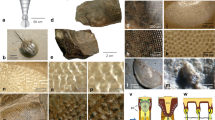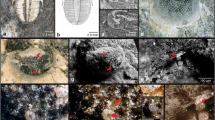Abstract
The two fundamental principles of image formation in compound eyes, apposition and superposition, have long been known to exist in both insects and crustaceans1. The scattered distribution of the two optical mechanisms2–4 indicates that one type can evolve into the other, but as they are so fundamentally different, it has been an enigma how such evolution could occur. In crustaceans, superposition eyes are present among the orders Mysidacea, Euphausiacea and Decapoda5. I now report that the planktonic larvae of most euphausiids and decapods possess a transparent type of apposition eye, designed for planktonic life, that is pre-adapted for superposition optics. This discovery suggests that the evolution of superposition eyes in crustaceans has its origin in the special apposition optics found in the larval eyes, thus providing the first evidence of an evolutionary link between apposition and superposition optics.
This is a preview of subscription content, access via your institution
Access options
Subscribe to this journal
Receive 51 print issues and online access
$199.00 per year
only $3.90 per issue
Buy this article
- Purchase on Springer Link
- Instant access to full article PDF
Prices may be subject to local taxes which are calculated during checkout
Similar content being viewed by others
References
Exner, S. Die Physiologie der Facettirten Augen von Krebsen und Insecten (Deuticke, Leipzig, 1891).
Kunze, P. in Handbk of Sensory Physiology Vol. 7/6A (ed. Autrum, H.) 441–502 (Springer, Berlin, 1979).
Land, M. F. in Handbk of Sensory Physiology Vol. 7/6B (ed. Autrum, H.) 471–592 (Springer, Berlin, 1981).
Fincham, A. A. Nature 287, 729–731 (1980).
Land, M. F. Nature 287, 681–686 (1980).
Cleary, P., Deichel, G. & Kunze, P. J. comp. Physiol. 119, 73–84 (1977).
Vogt, K. Z. Naturf. 30c, 691 (1975).
Land, M. F. Nature 263, 764–765 (1976).
Vogt, K. J. comp. Physiol. 135, 1–19 (1980).
Nilsson, D.-E., Andersson, M., Hallberg, E. & McIntyre, P. J. Microsc. (in the press).
Bryceson, K. P. J. exp. Biol. 90, 347–350 (1981).
Meggitt, S. & Meyer-Rochow, V. B. in The Compound Eye and Vision in Insects (ed. Horridge, G. A.) 314–320 (Clarendon, Oxford, 1975).
Nilsson, D.-E. J. comp. Physiol. 147, 339–349 (1982).
Nilsson, D.-E. & Nilsson, H. L. J. exp. mar. Biol. Ecol. 68 (1983).
Nilsson, D.-E. J. exp. Zool. 225, 161–165 (1983).
Land, M. F. in Sense Organs (eds Laverack, M. S. & Cosens, D. J.) 31–48 (Blackie, Glasgow, 1981).
Land, M. F. J. comp. Physiol. 145, 209–226 (1981).
Nilsson, D.-E., Odselius, R. & Elofsson, R. Cell Tissue Res. 230 (1983).
Author information
Authors and Affiliations
Rights and permissions
About this article
Cite this article
Nilsson, DE. Evolutionary links between apposition and superposition optics in crustacean eyes. Nature 302, 818–821 (1983). https://doi.org/10.1038/302818a0
Received:
Accepted:
Issue Date:
DOI: https://doi.org/10.1038/302818a0
This article is cited by
-
Giant planktic larvae of anomalan crustaceans and their unusual compound eyes
Helgoland Marine Research (2020)
-
Insights into a 429-million-year-old compound eye
Scientific Reports (2020)
-
Limit of colour vision in dim light in larvae of the giant freshwater prawn Macrobrachium rosenbergii
Fisheries Science (2018)
-
On the sighted ancestry of blindness – exceptionally preserved eyes of Mesozoic polychelidan lobsters
Zoological Letters (2016)
-
Spectral absorption of visual pigments in stomatopod larval photoreceptors
Journal of Comparative Physiology A (2016)
Comments
By submitting a comment you agree to abide by our Terms and Community Guidelines. If you find something abusive or that does not comply with our terms or guidelines please flag it as inappropriate.



